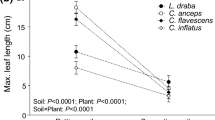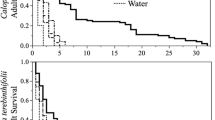Abstract
The foliage feeding geometridRhodometra sacraria L. was collected onEmex australis Steinheil in South Africa, cultured, then tested as a possible biological control agent forE. australis, in Australia. Tests on its host specificity were carried out in South Africa and Australia.R. sacraria was specific to plants of the familyPolygonaceae rather than toE. australis. Request for the reintroduction and release ofR. sacraria into Australia has not been made.
Résumé
Le géométride phytophageRhodometra sacraria a été récolté surEmex australis en Afrique du Sud, mis en élevage et testé comme agent possible de lutte biologique contreE. australis en Australie. Des tests sur sa spécificité ont été conduits en Afrique du Sud et en Australie.R. sacraria était plus spécifique des plantes de la famille des Polygonacées que deE. australis. La demande pour la réintroduction et le lâcher deR. sacraria en Australie n'a pas été faite.
Similar content being viewed by others
References
Auld, B. A. &Medd, R. W. — 1987. Weeds. An illustrated botanical guide to The Weeds of Australia. —Inkata Press, Melbourne.
Gilby, D. D. — 1974.Emex species in Australia with particular reference to Western Australia. —J. Aust. Inst. Agric. Sci., 40, 114–120.
Haggett, G. — 1952.Rhodometra sacraria [Lep.: Geometridae] in Great Britain with particular reference to its occurrence in West Sussex 1947. —The Entomol., 85, 49–56.
Harley, K. L. S., Kassulke, R. C. &Julien, M. H. — 1979. Biology and host specificity ofMicrothrix inconspicuella Ragonot [Lep.: Pyralidae], a natural enemy ofEmex australis in South Africa. —J. entomol. Soc. sth. Afr., 42, 343–348.
Julien, M. H. — 1981. A discussion of the limited establishment ofPerapion antiquum and a review of the current status of biological control ofEmex spp. in Australia. —Proc. 5th Int. Symp. Biol. Control Weeds, Brisbane, 1980, 507–514.
Julien, M. H., Kassulke, R. C. &Harley, K. L. S. — 1982.Lixus cribicollis [Col.: Curculionidae] for biological control of the weedsEmex spp. andRumex crispus in Australia. —Entomophaga, 27, 439–446.
Laithwaite, E., Watson, A. &Whalley, P. E. S. — 1975. The Dictionary of Butterflies and Moths in colour (W. D. Duckworth ed.). —Michel Joseph, London.
McBarron, E. J. — 1977. Medical and Veterinary Aspects of Plant Poisons in New South Wales. —Dept. Agric. New South Wales, 99–103.
Neser, S. — 1979. Observations in South Africa onMicrothrix inconspicuella Ragonot [Pycitinae: Pyralidae], a natural enemy ofEmex australis Steinhell. —J. entomol. Soc. sth. Afr., 42, 337–347.
Parsons, W. T. — 1977. Noxious Weeds of Victoria. —Inkata Press, Melbourne, 2nd edn.
Pinhey, E. C. G. — 1975. Moths of Southern Africa. Descriptions and colour illustrations of 1,183 species. —Tafleburg, Cape Town.
Wapshere, A. J. — 1974. A strategy for evaluating the safety of organisms for biological weed control. —Ann. Appl. Biol., 77, 201–211.
Author information
Authors and Affiliations
Rights and permissions
About this article
Cite this article
Shepherd, R.C.H. Host specificity testing ofRhodometra sacraria [Lep.: Geometridae], a possible biological control candidate forEmex australis in Australia. Entomophaga 34, 469–476 (1989). https://doi.org/10.1007/BF02374384
Received:
Accepted:
Issue Date:
DOI: https://doi.org/10.1007/BF02374384




